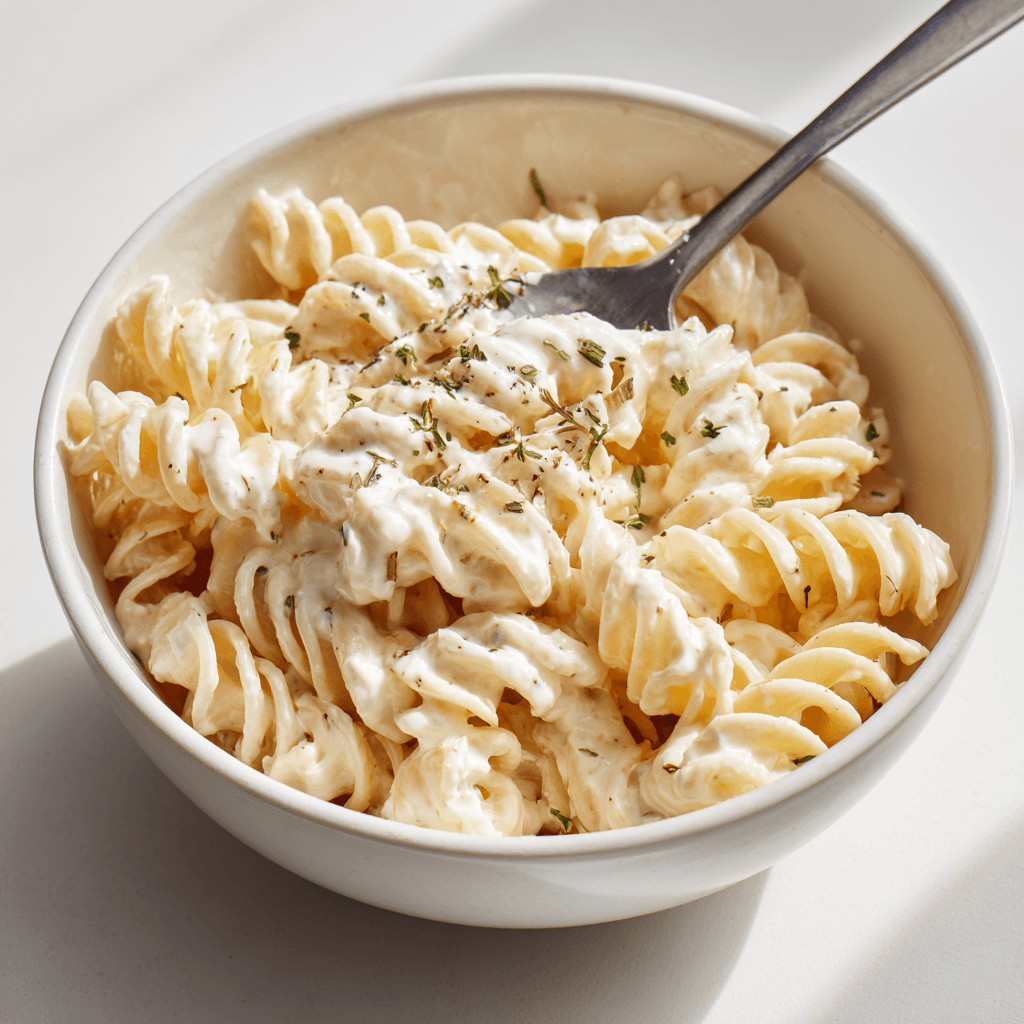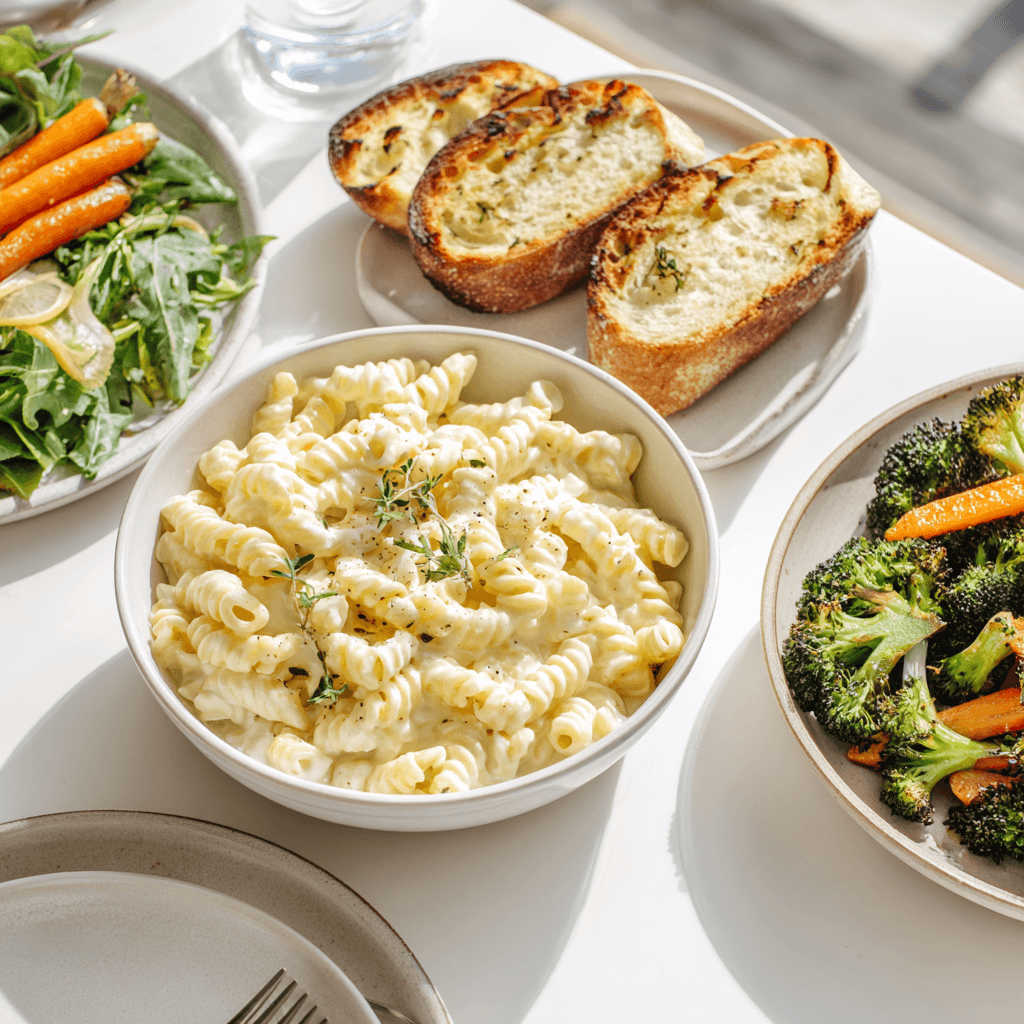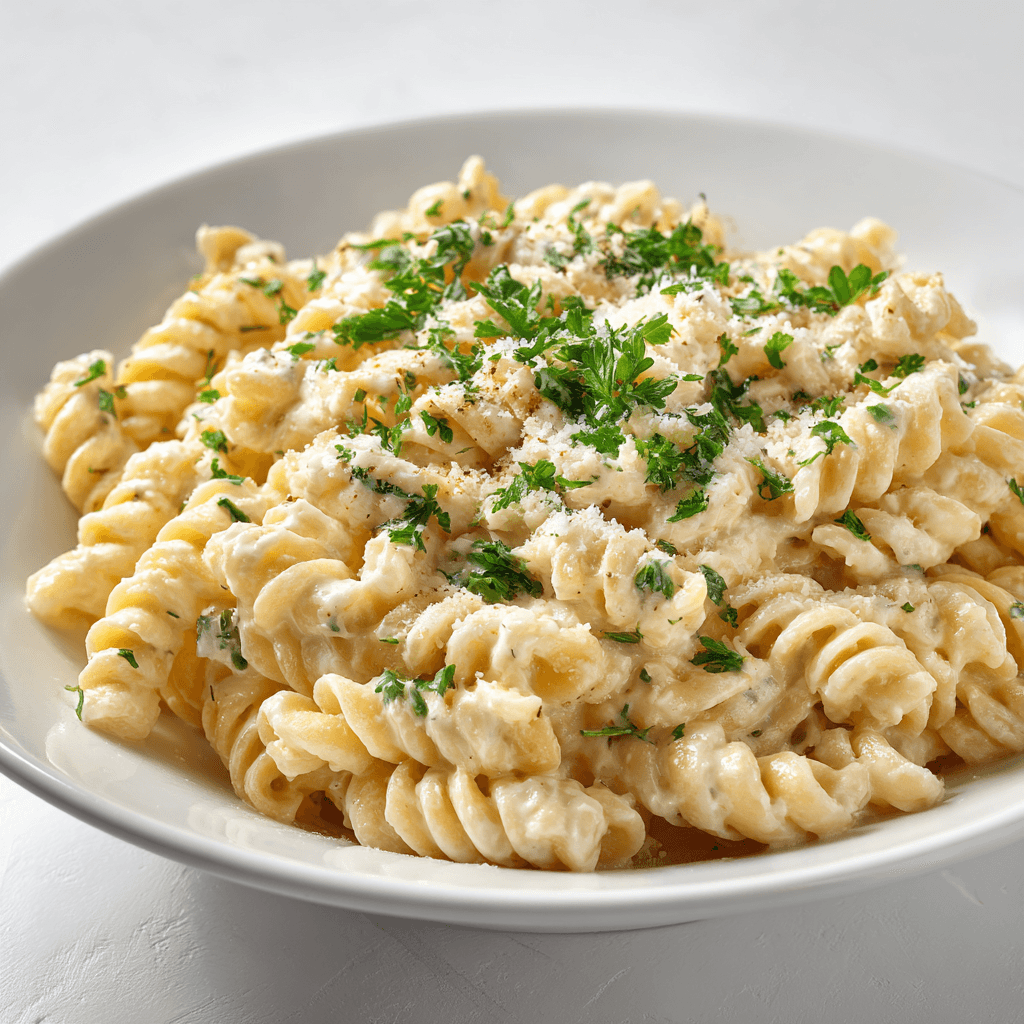Cottage cheese pasta is the ultimate blend of comfort and nutrition—a creamy, protein-rich twist on traditional pasta dishes. Unlike heavy cream sauces, this high protein pasta recipe creates a lightened-up yet satisfying dinner that’s quick to prepare on busy weeknights.
With a silky texture and homemade sauce, it proves you can enjoy creamy pasta without sacrificing health. Packed with flavor, versatile enough for endless variations, and ready in under 30 minutes, cottage cheese pasta is a healthy pasta recipe that delivers both convenience and nourishment.
Table of Contents
My Cottage Cheese Pasta Story
Growing up in San Antonio, I watched my mom transform simple ingredients into meals that fed both body and soul. Her food truck hustle showed me the power of comfort food done right.
Now, raising a family just outside Austin, I bring that same energy into my kitchen. Cottage cheese pasta became a favorite when I needed a creamy, high protein dinner without the heaviness of Alfredo.
Blending cottage cheese into a silky sauce felt like the perfect balance—flavorful, fast, and family-friendly. It’s proof that healthy swaps don’t mean giving up taste, just making comfort food work smarter for real life.
Why Make Pasta With Cottage Cheese?

Cottage cheese pasta is more than a trend—it’s a smart, protein-packed swap for heavy cream sauces. A single cup of cottage cheese delivers about 25 grams of protein, making it a macro-friendly base for high protein pasta dishes.
Compared to Alfredo or béchamel, this healthy pasta recipe is lighter, lower in fat, and still offers a creamy sauce with a silky texture. Calcium and B vitamins give it extra nutritional value, making it a balanced, family-friendly option.
When you choose cottage cheese over cream or ricotta, you cut calories while keeping flavor:
- Alfredo sauce: up to 800 calories per serving.
- Cottage cheese pasta: significantly lighter, yet still satisfying.
- Extra nutrition: protein, calcium, and B vitamins in every serving.
This healthy swap feels indulgent without weighing you down. Pairing it with protein-rich add-ins like grilled chicken is another way to boost nutrients, similar to my baked boneless chicken thighs recipe.
Ingredients You’ll Need

Making cottage cheese pasta is simple, but the right ingredients ensure flavor and balance. Start with a few basics and build with flavor boosters or protein add-ins.
The foundation of this creamy pasta comes from simple staples:
- Cottage cheese – choose full-fat for richness or low-fat for a lightened-up version.
- Pasta – classics like fusilli or penne hold sauce well, but gluten-free pasta, chickpea pasta, or even zucchini noodles work too.
- Garlic and onion – build savory depth that balances the tang of cottage cheese.
- Olive oil – adds smoothness and helps coat each bite.
For another creative pasta dish, check out my baked Spanakopita pasta where base ingredients get an exciting Mediterranean twist.
Flavor Boosters & Variations
Small touches turn this into a personalized healthy pasta recipe:
- Cheese & herbs – Parmesan, basil, parsley, nutmeg, or lemon zest.
- Veggies – spinach, mushrooms, broccoli, roasted red peppers.
- Proteins – grilled chicken, ground turkey, shrimp, or tofu for vegetarian pasta options.
If you enjoy versatile, protein-packed meals, you’ll also love my cottage cheese bagels — proof that this ingredient can shine well beyond pasta.
How To Make Cottage Cheese Pasta
Making cottage cheese pasta is quick, but paying attention to the details ensures a silky, creamy sauce every time. Here’s how to do it:
Step 1 – Blend the Cottage Cheese Sauce
Add cottage cheese, garlic, Parmesan, seasonings, and a splash of pasta water to a blender. Puree until the sauce looks velvety smooth.
- Blending breaks down curds for a creamy sauce.
- Pasta water starch helps emulsify and bind the sauce.
- Taste and adjust with lemon zest or herbs if needed.
For another silky sauce technique, I use a similar blending trick in my lobster bisque recipe to create a restaurant-quality finish.
Step 2 – Cook the Pasta
Bring a large pot of salted water to a boil. Add your pasta and cook until al dente. Before draining, reserve at least one cup of pasta water.
- Al dente pasta holds shape and absorbs sauce better.
- Reserved pasta water starch acts as a natural sauce binder.
- Works well with penne, fusilli, spaghetti, or gluten-free pasta alternatives.
For more inspiration on pasta shapes and textures, you can explore my chicken spaghetti recipe, which shows how sauces cling to different noodles.
Step 3 – Combine & Heat Carefully
Add the blended sauce to the drained pasta over low heat. Stir continuously and let it coat each piece evenly.
- Low heat prevents protein from denaturing too quickly, which causes curdling.
- Continuous stirring ensures the sauce emulsifies smoothly.
- The result is a creamy, silky pasta that doesn’t separate.
This step is all about patience—gentle heat transforms cottage cheese into a sauce that feels indulgent but stays light.
Variations of Cottage Cheese Pasta
One of the best parts about cottage cheese pasta is its flexibility. You can keep it vegetarian, bulk it up with protein, or even make it dairy-free or gluten-free.
Vegetarian Cottage Cheese Pasta
Load up the sauce with fresh vegetables for a balanced, meatless dinner:
- Spinach, mushrooms, zucchini, or broccoli add color and nutrients.
- Roasted red peppers give a smoky sweetness.
- A sprinkle of Parmesan ties it all together.
If you enjoy veggie-forward comfort food, you’ll love my vegan meatloaf, another hearty meatless dinner.
Meat & Protein Variations
Boost the protein content to make this a filling main course:
- Ground turkey for a lean, savory option.
- Grilled chicken breast for a high protein pasta twist.
- Shrimp for a lighter, seafood-inspired version.
Pairing protein with pasta is a go-to move in my chicken Parmesan with spaghetti, where every bite delivers comfort and balance.
Dairy-Free & Vegan Adaptation
For a dairy-free or vegan pasta sauce, swap the cottage cheese with:
- Silken tofu blended with lemon juice for tang.
- Cashews soaked and blended for creamy texture.
- Oat milk for a lighter, nut-free option.
These swaps create a silky sauce that’s both plant-based and satisfying.
Gluten-Free Versions
Don’t let gluten stop you from enjoying this creamy pasta dinner. Try:
- Chickpea or lentil pasta for extra protein.
- Rice pasta for a neutral, mild option.
- Zucchini noodles for a low-carb swap.
Each version holds the sauce differently, but all keep that velvety, creamy texture intact.
What to Serve With Cottage Cheese Pasta

Cottage cheese pasta is satisfying on its own, but the right sides can turn it into a complete meal. Think balance: something crisp, something warm, and maybe a little extra protein.
Great pairings include:
- Garlic bread – buttery, crunchy, and perfect for scooping up extra creamy sauce.
- Fresh side salad – a crisp green salad with lemon vinaigrette balances the richness.
- Roasted vegetables – broccoli, asparagus, or carrots add color and nutrition.
- Grilled chicken or shrimp – for an even more protein-packed dinner.
For another easy pasta night upgrade, you can serve this dish the way I pair flavors in my chicken spaghetti casserole — creamy pasta balanced with a crunchy or fresh side. If you prefer lighter pairings, my big mac salad is a fun, refreshing option that surprises everyone at the table.
Storage, Leftovers & Meal Prep
Cottage cheese pasta reheats well if you store it correctly. Because the sauce is protein-rich, a little care prevents separation and keeps that silky texture.
Here’s how to handle leftovers:
- Refrigerate – Store in an airtight container for up to 3 days. Add a splash of milk or pasta water when reheating to bring back creaminess.
- Freeze – Best for plain sauce without pasta, as freezing pasta can change its texture. Freeze in portions for up to 2 months.
- Reheat – Warm gently over low heat while stirring. This prevents curdling and keeps the sauce smooth.
Meal preppers love this recipe because it’s versatile. Pair a reheated serving with fresh vegetables or protein, similar to how I portion out my protein chia seed pudding for balanced weeks. For another smart leftover-friendly dinner, my crockpot French onion meatloaf is another comfort meal that stores and reheats beautifully.
Frequently Asked Questions
Can you use cottage cheese in pasta?
Yes! Cottage cheese works wonderfully in pasta. When blended, it turns into a creamy sauce that coats noodles with a light, velvety texture. Unlike heavy cream or Alfredo sauce, it offers a healthier balance of protein and calcium while staying much lower in fat. It’s a smart choice for anyone looking for a quick, protein-rich dinner that still feels indulgent.
Does cottage cheese melt well in pasta?
Not in the same way as mozzarella or cheddar. Cottage cheese won’t melt into strings or pools, but blending it breaks down the curds into a smooth, silky mixture. Once combined with pasta water starch and heated gently, it creates a sauce that clings perfectly to pasta without separating.
Can I use cottage cheese instead of ricotta in pasta?
Absolutely. Cottage cheese is a fantastic substitute for ricotta, especially if you want to cut calories while boosting protein. Its mild flavor blends seamlessly into baked pasta dishes or quick stovetop sauces. Just remember to blend it first for that same creamy consistency ricotta provides.
Can cottage cheese replace cream in pasta?
Yes, cottage cheese can replace cream in pasta recipes. Blending it creates a thick, velvety sauce without the heaviness of cream. It’s also less likely to overpower other flavors, letting herbs, garlic, and Parmesan shine through. With the added benefit of higher protein and fewer calories, it’s a smart way to lighten up your favorite creamy pasta dinners.
Conclusion – The Best Way to Enjoy Cottage Cheese Pasta

Cottage cheese pasta proves that comfort food can be both healthy and satisfying. By blending cottage cheese into a silky sauce, you get all the creamy indulgence of a classic pasta dinner without the heaviness of cream or Alfredo.
It’s protein-packed, versatile, and quick to make, whether you keep it vegetarian, add chicken or shrimp, or go gluten-free.
The best way to enjoy cottage cheese pasta is to make it your own—experiment with variations, pair it with fresh sides, and let it become a weeknight staple. Try it tonight as a quick, creamy, protein-packed dinner that feels as good as it tastes.

Cottage Cheese Pasta
Ingredients
Equipment
Method
- Heat olive oil in a large skillet. Sauté onion and garlic until fragrant and softened.
- Add ground turkey and cook until browned and fully cooked through.
- Stir in red bell pepper, basil, red pepper flakes, and chopped spinach. Cook until veggies are tender and spinach is wilted.
- Meanwhile, cook pasta in salted water until al dente. Drain and reserve some pasta water.
- Combine cooked pasta with meat and veggie mixture. Add cottage cheese sauce and a splash of reserved pasta water. Stir over low heat until creamy and well combined.
- Season with salt and pepper. Serve topped with fresh basil and grated Parmesan if desired.
Nutrition
Notes
- To make this recipe vegetarian, skip the turkey and add more spinach, mushrooms, or cooked lentils for extra protein and texture.
- For a dairy-free version, replace the cottage cheese sauce with a blend of silken tofu or soaked cashews and lemon juice.
- Serve with garlic bread, a green salad, or roasted veggies for a complete meal.
Tried this recipe?
Let us know how it was!Looking for more comfort recipe like this? Come hang out with me over on Facebook and Pinterest where I drop new recipes, family favorites, and quick how-to guides almost every day.


1 thought on “Cottage Cheese Pasta – Creamy, Healthy, and Protein-Packed”